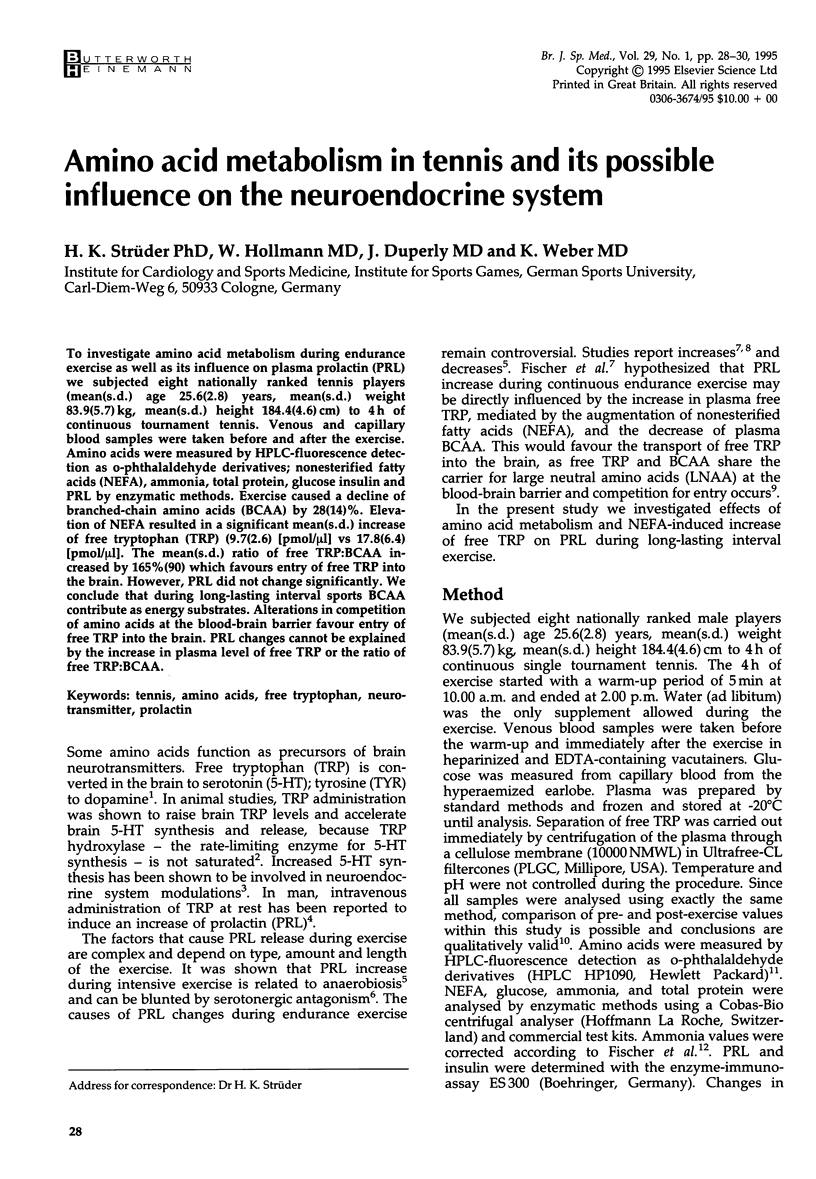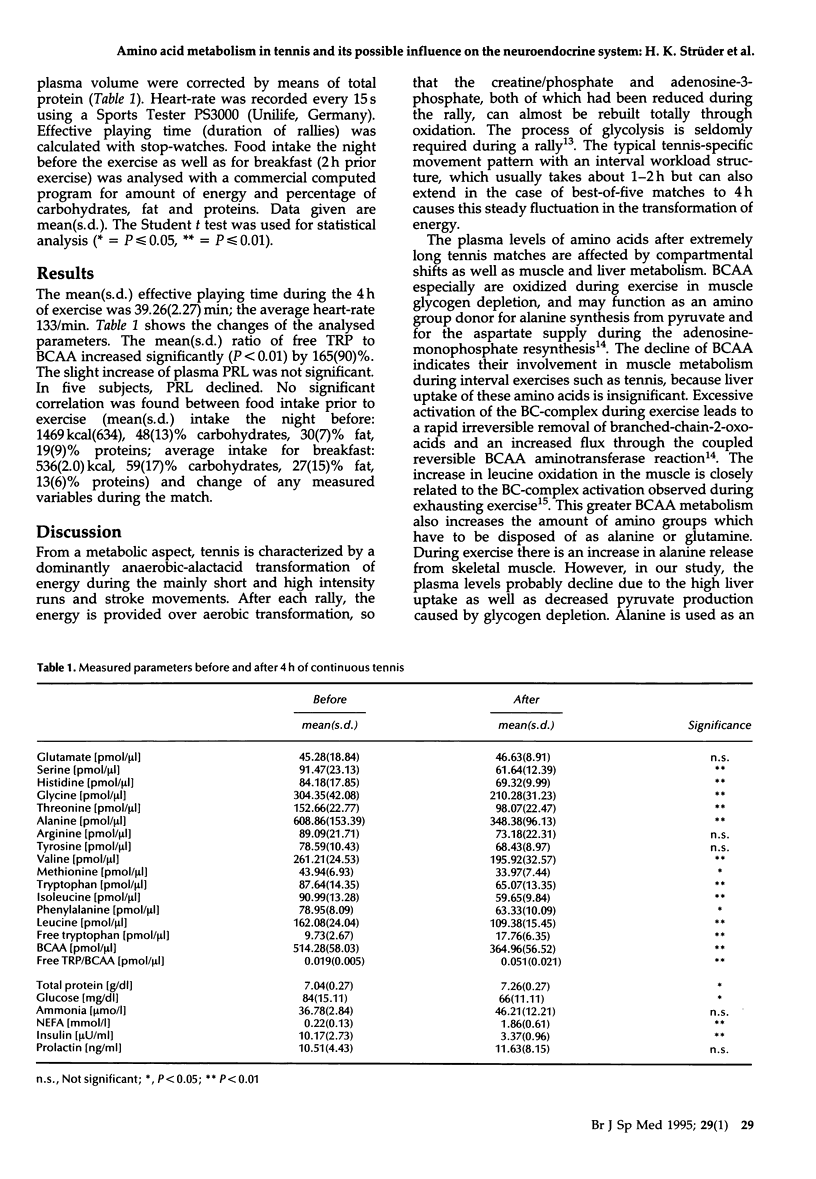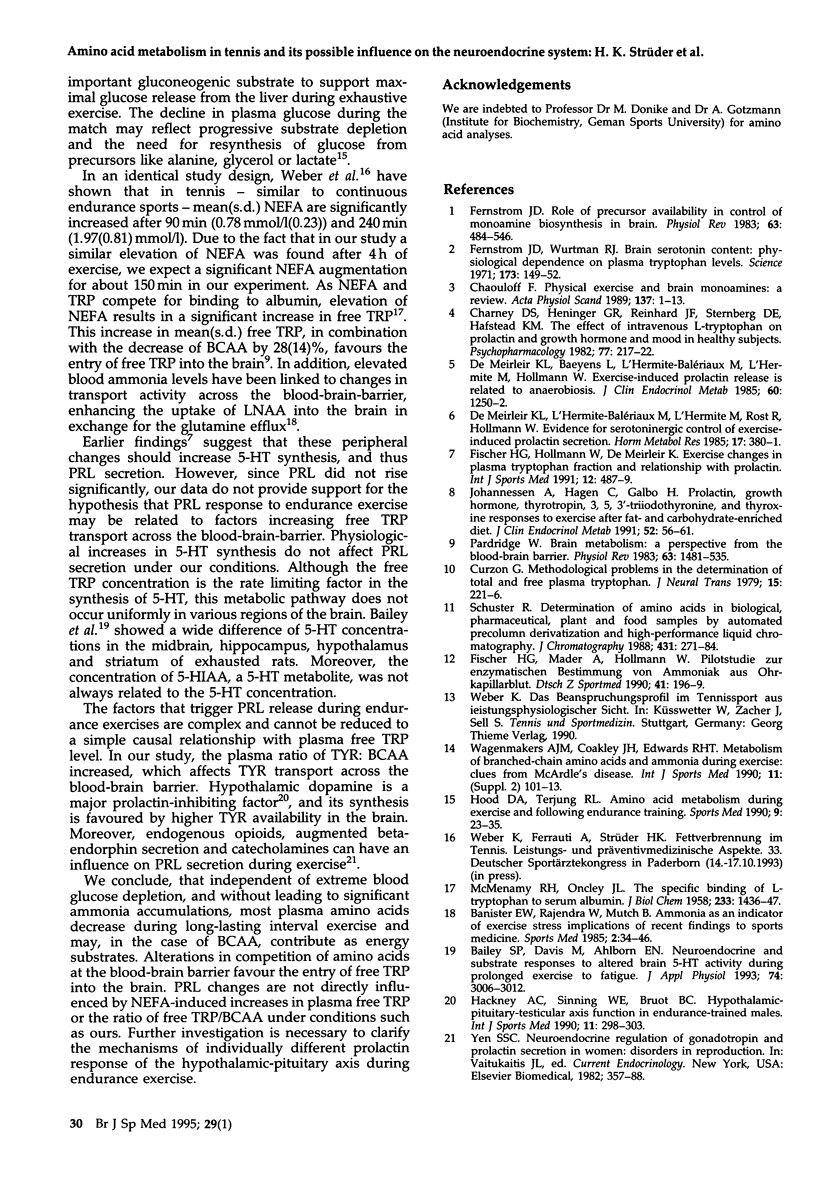Abstract
To investigate amino acid metabolism during endurance exercise as well as its influence on plasma prolactin (PRL) we subjected eight nationally ranked tennis players (mean(s.d.) age 25.6(2.8) years, mean(s.d.) weight 83.9(5.7) kg, mean(s.d.) height 184.4(4.6) cm) to 4h of continuous tournament tennis. Venous and capillary blood samples were taken before and after the exercise. Amino acids were measured by HPLC-fluorescence detection as o-phthalaldehyde derivatives; nonesterified fatty acids (NEFA), ammonia, total protein, glucose insulin and PRL by enzymatic methods. Exercise caused a decline of branched-chain amino acids (BCAA) by 28(14)%. Elevation of NEFA resulted in a significant mean(s.d.) increase of free tryptophan (TRP) (9.7(2.6) [pmol/microliter] vs 17.8(6.4) [pmol/microliter]. The mean(s.d.) ratio of free TRP:BCAA increased by 165%(90) which favours entry of free TRP into the brain. However, PRL did not change significantly. We conclude that during long-lasting interval sports BCAA contribute as energy substrates. Alterations in competition of amino acids at the blood-brain barrier favour entry of free TRP into the brain. PRL changes cannot be explained by the increase in plasma level of free TRP or the ratio of free TRP:BCAA.
Full text
PDF


Selected References
These references are in PubMed. This may not be the complete list of references from this article.
- Bailey S. P., Davis J. M., Ahlborn E. N. Neuroendocrine and substrate responses to altered brain 5-HT activity during prolonged exercise to fatigue. J Appl Physiol (1985) 1993 Jun;74(6):3006–3012. doi: 10.1152/jappl.1993.74.6.3006. [DOI] [PubMed] [Google Scholar]
- Banister E. W., Rajendra W., Mutch B. J. Ammonia as an indicator of exercise stress implications of recent findings to sports medicine. Sports Med. 1985 Jan-Feb;2(1):34–46. doi: 10.2165/00007256-198502010-00004. [DOI] [PubMed] [Google Scholar]
- Chaouloff F. Physical exercise and brain monoamines: a review. Acta Physiol Scand. 1989 Sep;137(1):1–13. doi: 10.1111/j.1748-1716.1989.tb08715.x. [DOI] [PubMed] [Google Scholar]
- Charney D. S., Heninger G. R., Reinhard J. F., Jr, Sternberg D. E., Hafstead K. M. The effect of intravenous L-tryptophan on prolactin and growth hormone and mood in healthy subjects. Psychopharmacology (Berl) 1982;77(3):217–222. doi: 10.1007/BF00464569. [DOI] [PubMed] [Google Scholar]
- Curzon G. Methodological problems in the determination of total and free plasma tryptophan. J Neural Transm Suppl. 1979;(15):221–226. doi: 10.1007/978-3-7091-2243-3_21. [DOI] [PubMed] [Google Scholar]
- De Meirleir K. L., Baeyens L., L'Hermite-Baleriaux M., L'Hermite M., Hollmann W. Exercise-induced prolactin release is related to anaerobiosis. J Clin Endocrinol Metab. 1985 Jun;60(6):1250–1252. doi: 10.1210/jcem-60-6-1250. [DOI] [PubMed] [Google Scholar]
- De Meirleir K., L'Hermite-Balériaux M., L'Hermite M., Rost R., Hollmann W. Evidence for serotoninergic control of exercise-induced prolactin secretion. Horm Metab Res. 1985 Jul;17(7):380–381. doi: 10.1055/s-2007-1013551. [DOI] [PubMed] [Google Scholar]
- Fernstrom J. D. Role of precursor availability in control of monoamine biosynthesis in brain. Physiol Rev. 1983 Apr;63(2):484–546. doi: 10.1152/physrev.1983.63.2.484. [DOI] [PubMed] [Google Scholar]
- Fernstrom J. D., Wurtman R. J. Brain serotonin content: physiological dependence on plasma tryptophan levels. Science. 1971 Jul 9;173(3992):149–152. doi: 10.1126/science.173.3992.149. [DOI] [PubMed] [Google Scholar]
- Fischer H. G., Hollmann W., De Meirleir K. Exercise changes in plasma tryptophan fractions and relationship with prolactin. Int J Sports Med. 1991 Oct;12(5):487–489. doi: 10.1055/s-2007-1024719. [DOI] [PubMed] [Google Scholar]
- Hackney A. C., Sinning W. E., Bruot B. C. Hypothalamic-pituitary-testicular axis function in endurance-trained males. Int J Sports Med. 1990 Aug;11(4):298–303. doi: 10.1055/s-2007-1024811. [DOI] [PubMed] [Google Scholar]
- Hood D. A., Terjung R. L. Amino acid metabolism during exercise and following endurance training. Sports Med. 1990 Jan;9(1):23–35. doi: 10.2165/00007256-199009010-00003. [DOI] [PubMed] [Google Scholar]
- Johannessen A., Hagen C., Galbo H. Prolactin, growth hormone, thyrotropin, 3,5,3'-triiodothyronine, and thyroxine responses to exercise after fat- and carbohydrate-enriched diet. J Clin Endocrinol Metab. 1981 Jan;52(1):56–61. doi: 10.1210/jcem-52-1-56. [DOI] [PubMed] [Google Scholar]
- McMENAMY R. H., ONCLEY J. L. The specific binding of L-tryptophan to serum albumin. J Biol Chem. 1958 Dec;233(6):1436–1447. [PubMed] [Google Scholar]
- Pardridge W. M. Brain metabolism: a perspective from the blood-brain barrier. Physiol Rev. 1983 Oct;63(4):1481–1535. doi: 10.1152/physrev.1983.63.4.1481. [DOI] [PubMed] [Google Scholar]
- Schuster R. Determination of amino acids in biological, pharmaceutical, plant and food samples by automated precolumn derivatization and high-performance liquid chromatography. J Chromatogr. 1988 Oct 14;431(2):271–284. doi: 10.1016/s0378-4347(00)83096-0. [DOI] [PubMed] [Google Scholar]


